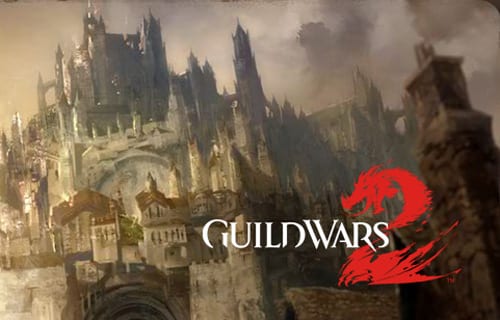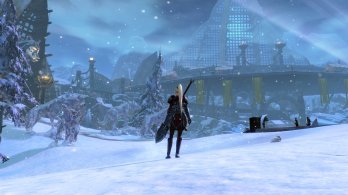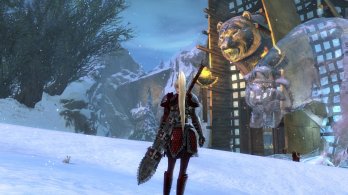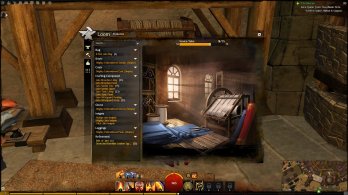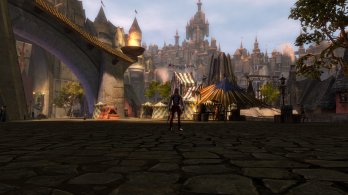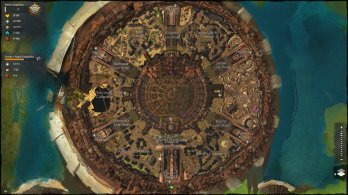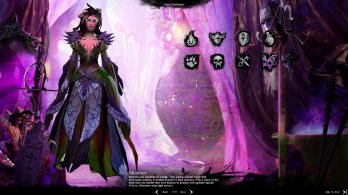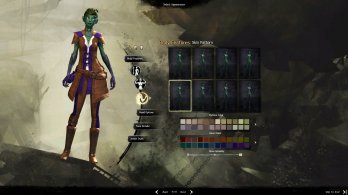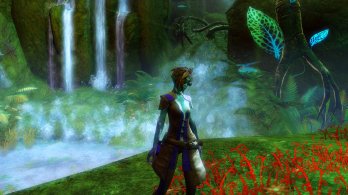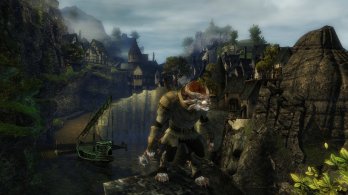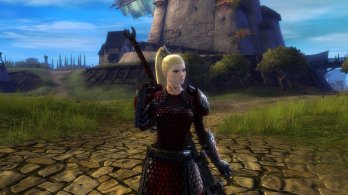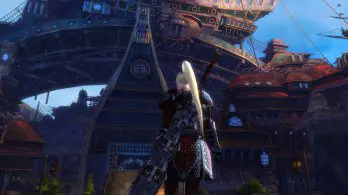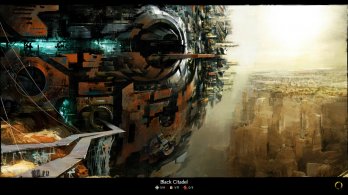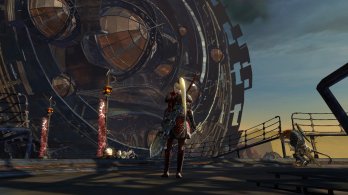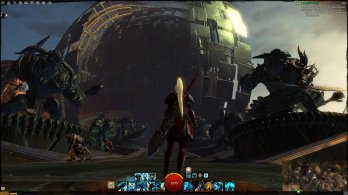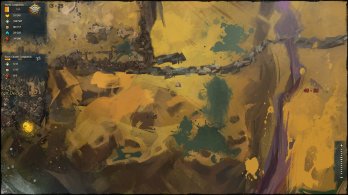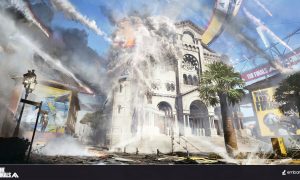
I’ll start off with an admission – I played the original Guild Wars for all of about 5 hours. Frankly I just didn’t have a lot of time and for whatever reason the game didn’t click with me. When Guild Wars 2 was announced in March of 2007 I really didn’t pay it any mind. When the first trailer hit in 2009 I raised an eyebrow, but know that most MMOs are heavy on promise and light on delivery. It wasn’t until a few more videos showed us exactly what Arenanet was doing differently that I began to take notice. While this review will be as comprehensive as I can be, Guild Wars 2 will take some time to fully explore. I’ve co-authored this review with Victor Grunn who will be tackling the PvP elements of the game, while I handle PvE and the game mechanics. Let’s return to the world of Tyria and experience something completely different.
Guild Wars 2 takes place on Tyria, the same world as the previous title and the expansion packs, but over 250 years have passed. In that quarter millenia, a great many things of changed. The war between the humans and Charr has taken a toll, and the humans are very much on their heels, having lost Ascalon to the proud beast-warriors. The Norn are already under assault by the Elder Ice Dragon, Jormag, and have been forced to retreat to the frozen North to survive. The diminutive-yet-powerful Asura have also been attacked by an Elder dragon; Primordus has forced them to all but evacuate their subterranean homes in favor of unfamiliar dwellings above ground. Even a new race, the gentle plant-based group called the Sylvari, have emerged from the forests near the home of the Asura in the last 25 years. While the story may not be a huge divergence from the MMO standard, the game itself is.
Building the Next Generation of MMO
[singlepic id=8970 w=320 h=240 float=left]The folks at Arenanet set out to turn the MMO market on its ear by setting forth several main pillars that they would wrap the rest of the game around. The first is a living world that the player would be able to impact with their actions. This means that the first thing they discarded was the traditional quest system. No longer do you schlep through town to gather up all your quests and then set across the landscape to solve them all at once. Instead, the quests are gathered as you encounter them, often being overheard in NPC conversation or being granted as you happen to run across them. To illustrate this living world and not spoil any quests, we’ll use an oft-cited example from the starting area – the centaur threat. In the first town you’ll find a centaur threat nearby that can assault the town. If you and other players don’t repel the attack, they can eventually push into the town and eventually destroy it, killing crucial NPCs in the process. Similarly, there is a nearby set of pipes that feed water to the nearby farms. If you don’t stop the bandit threat, they may breach the pipes, poison the water, and otherwise disrupt the health of the area. It is in this first pillar that I think Arenanet succeeded as well as had a bit of underestimation.
The quests work as intended on the surface – you’ll encounter them at hearts that show up on the map, but in over 35 levels I’ve not seen a single quest that managed to not get completed in it’s first stage. This means that you’ll never see the second stage (the bandits breach the pipes) or the third stage (the water affects the farm and poisons the people) or anything beyond. It is a happy consequence of having FAR more people than they likely anticipated in the game simultaneously.
The second pillar is one that players need to be able to partner up and play without all the usual pain and aggravation of grouping up. Having played quite a few myself I was pretty happy to see the Kindle Fire come out. I say that as I spend nearly as much time catching up on reading as I do playing, waiting for groups to form. Once you get the group formed, inevitably somebody will have to drop for wife aggro or some other issue. Similar to a system we’ve seen in The Lord of the Rings Online, Guild Wars 2 allows players to join any quest in progress ad hoc. This means that you can jump in at any point, and as long as you do enough damage to qualify as a valid participant (this reduces “twinking” of characters), you’ll get full XP, and full loot for your work. It isn’t ‘locked’ to the person attacking, and it isn’t locked to a party, but don’t think that mobbing is going to get it done – there[singlepic id=8969 w=320 h=240 float=right] is a twist. The world of Guild Wars 2 scales dynamically. This means that if you are playing in an event that has you attacking a garrison and more people join the assault, the game will react by having more enemies join the fray. They may also switch up their attacks to utilize more AoE attacks, or otherwise use skills that are more suited to combat more players. This extends to single monsters as they may have more hit points or use more agile tactics as their threat grows. There are boss monsters in the world that do not scale, but these creatures require a good number of characters to take down anyway. While all of this sounds like ArenaNet is discouraging parties, this isn’t the case. If you are in a party you’ll get a separate chat channel and you can mark the compass with waypoints. Beyond that, in short, anyone who is near you is technically in your impromptu party. There are occasional moments where you’ll get full credit for a mission you had nothing to do with, but for the most part, this pillar is solid.
The final pillar that ArenaNet wanted to focus on was storytelling. The first Guild Wars title was broken into instanced missions, but Guild Wars 2 is a fully persistent online world. ArenaNet asked once “What is it that single player RPGs have that MMOs don’t?” The answer is simple – give players their own personal stories. Each of the five races have multiple choices that they can pick in the very beginning of the game (15 total permutations in all) that lead to further choices roughly every 10 levels. These aren’t the usual moral choices that don’t have any weight or impact, but instead can be as simple as which of three factions to join (stealth, gadgets, or full-on combat), or as severe as having to choose between saving your best friend or the innocent people of a nearby town. With a level cap of 80, you can see that these career choices for your character could lend to some alts beyond just playing another race.
Baking Bread
[singlepic id=8953 w=320 h=240 float=left]It just wouldn’t be a complete MMO without the ability to craft. The approach to crafting is similar but slightly different than other titles. You will pick two professions from the usual suspects; armor smithing, weapon crafting, tailor, jewelry maker, cook, and more, but this time you won’t have to consume either of those professions with gathering as everyone can gather everything. To further press the non-griefing aspects of the game, resource nodes are not ‘first come, first served’ but instead persistent for each player. Somebody can race to a node and mine it and you can throw your pick at it right afterwards and receive the same reward. The same goes for gathering wood and harvesting plants, though you’ll have to still get skins and meat the old fashioned way. This leads to a major part of the game – salvage.
If you aren’t the crafting type but you want to collect mats for those who are, you’ll have to contend with salvaging. While you don’t use a trade slot for gathering, you’ll need tools. Tiered into several types of axes, scythes, and picks, anyone can purchase the utilities to grab any of the nodes mentioned above. In addition, you’ll likely need to break those items down or the weapons and armor you pick up off of mobs into their base components. You can buy (again, tiered) salvage kits that will allow you to turn your shiny new Axe of McGuffin Slaying into chunks of copper, remove the runes or sigils, break the handle into a polished dowel, or other varied states of deconstruction. When you get to the endgame, you’ll need a large pool of these salvage assets to shine your gear into something more powerful.
When your level takes you high enough you’ll be able to visit Lion’s Arch and the Mystic Forge contained therein. When you complete some of the major objectives you’ll occasionally be given strange coins that can be used to forge new high-end weapons and armor. Similarly, this forge can be used similarly to the Horadric Cube in Diablo II. That is to say that you can transmute quantities of crafting supplies into one from a higher tier. 4 pieces of copper can become a piece of silver and so on. Players are hacking hard at learning how to use this powerful device, and a great deal of it is unknown at this point, but it’ll be exciting to find out.[singlepic id=8967 w=320 h=240 float=right]
The crafting engine is one that suggests exploration. You’ll craft the individual pieces of the object you are looking to create and then combine them with the various insignias, gems, or whatever is appropriate for the item. The most basic of recipes are straightforward, but putting a single piece onto the crafting box tells you that there are recipes beyond the norm for you to discover as you dig. Crafting from the already-known recipe list will give you a little bit of XP and a bump in your crafting skill, but discovering new recipes gives a massive bonus to both. This alleviates the “make 50 Foozle Helmets of Gibbing” formula present in most MMOs. Unfortunately, even with the crazy accessibility of the Trading Post, it falls victim to a familiar trap – nobody wants to buy your lovingly hand-crafted crap. Put simply, the components needed to make a very powerful item will net you less than 10% of the cost it took to make it. Perhaps this’ll even out as more players get into the game, but I rather doubt it.
If you have RPG ADD like I do, you’ll find yourself creating alts just to have your crafting skill bases covered. In Guild Wars 2 you can have any two crafting skills active, and switching between them only costs you coin. The best part is that you don’t lose skills or recipes by switching – in this game it is possible that a player can truly become a jack of ALL trades.
To assist in crafting, anything you collect that is categorized as a crafting item can be dropped into a ‘collectable’ portion of your bank. That means that any resource you might use (up to 250 of each type) can be used to craft directly from the forge or wherever without the need to first drag it to your bank box. Even better than that – this collectable space, like your main bank box, is shared on an account level rather than per-character. No longer do you have to mule mats back and forth. When you think about the fact that you earn experience points by simply crafting, and that you can level this way, baking bread becomes a viable adventurer profession!
Of Swords, Spells, Vistas, and Overflows
[singlepic id=8966 w=320 h=240 float=left]As I mentioned before, Guild Wars 2 features 5 playable races, but these are less important than the 8 character classes. You see, other than the obvious ties to unique stories, starting experiences, and initial storyline, Guild Wars 2 has also divorced itself from the idea of racial restriction. That is to say that you can play a Charr Mesmer, or a Sylvari Guardian. You could also take a Norn Thief to the field just as easily as a Human Engineer. The choice of character class is entirely based on how you’d like to play – this is one time where picking what looks cool is a completely valid option. You only have 5 character slots (though you can buy more with real money – more on that in a moment) so you’ll have to choose wisely.
Mechanically, combat is engaging. Your first five slots are your primary attacks, and the last 5 are unlocked via level and spending skill points. While this sounds horribly limiting, those five initial slots change every time you change weapons. Warrior classes can switch between two weapon sets (e.g. giant hammer and sword/shield) so you’ll see those first five attacks switch to represent the types of attacks you’d expect for that type of implement. Caster classes have different elements or spell types that they can switch between, allowing an even larger pool of attacks. Switching weapons or spell types has a cooldown, but you will still be switching weapons and attacks frequently, depending on the number and type of enemies.
As you reach level 10 you’ll begin earning skill points and eventually Traits. Skill points allow you to select individual attack types including various buffs, summons, illusions, and more. Traits are more passive skills picked from five different trees. Depending on your class this may allow faster skill recharge, setting fire to an enemy, and much more in addition to buffing health, damage, and other traits. At level 80, the cap, you’ll continue to gain XP and fill your level bar allowing you to gain additional skill points, though you don’t get any more trait points – just as it functioned in the original Guild Wars.[singlepic id=8962 w=320 h=240 float=right]
To further ensure that you can play with your friends, Guild Wars 2 adjusts your level. This means that if your friend is level 5 and you are level 10 and you head back to the level 5 area, your level will be adjusted down to 5 or 6. You don’t lose any skills, weapons, or armor, but you will do less damage and have fewer hitpoints. Each area has several points of interest, vistas (cool high points to get a good look at the area, often preceded by a jumping puzzle), waypoints, challenges, and skill point challenges, so you’ll likely be going back to previous areas and experiencing this first hand. Getting all of the aforementioned discovery elements yields you a box of unknown goodies, so it pays to be thorough.
There is one aspect of Guild Wars 2 that is somewhat confusing, but I’m here to clear it up – Overflow Servers. Before I explain, let me pose this question – do you like sitting at a login screen and reading, waiting for your chance to get into a server? If you do then Guild Wars 2 isn’t for you because you won’t ever see that screen. Rather than waiting to log in, you’ll likely be put into an Overflow Server. These servers function 100% (at least as I can see so far) like your normal one, with one exception – you won’t see people who are on that home server. If you wait a short while the game will prompt you to bounce back to your main server. When the game launched, this was very frequent, but as ArenaNet works to shore up their environments I’ve seen it less and less. All of that said, let’s dispel this right up front – yes you can play with your friends in the Overflow Server. If you party up, the game will allow players to remain bound together in that instance, allowing you to enjoy the game with your friends regardless of where your 1s and 0s happen to be.
For The Love Of Money
[singlepic id=8959 w=320 h=240 float=left]So all of this rivals many of the MMO titles out there, but there is one absolutely massive difference – Guild Wars 2 is free. So how does ArenaNet pay their bills? Let’s talk about the Black Lion Trading Company. The BLTC serves as the auction house and trading post for the game, giving players the ability to buy and sell items found in-game. This would be where you would lose money on those crafted items I mentioned before, and can also be where you find an awesome weapon you might otherwise never see. It’s also where you can find hard-to-find reagents and crafting items, should you run low. None of that is making real money, so what does? Top Hats and Aviator Sunglasses, that’s what.
In the BLTC you’ll be able to buy purely cosmetic items. These can be hats, glasses, pirate outfits, little mini critters to follow you around, and much more. You can also buy some boosts that’ll give you additional XP, magic find, and more, but there is nothing character-affecting that could be described as “pay to win”. For instance, you can pick up an awesome armor set that looks absolutely badass, but it’s just a skin – you’ll apply it to what you are already wearing and it inherits those attributes. If none of that sounds like it might be something you’d buy, I can tell you what will be – character slots and bank bags. You are given 5 slots for characters and 5 slots for bags, but you are allowed to purchase additional using gems. You’ll find Black Lion chests that can only be opened with special keys that you’ll occasionally find, but mostly can get from the BLTC, again via the gem system. You can use your in-game money to buy gems, so technically you could get those items without spending any real money, but like you might see in World of Tanks or Tribes: Ascend, I suspect a lot of folks will take the shortcut and dip into their pockets for a little bit of a shortcut.
The guild system is another area where players will have to sink their time. You can form your own guild, you can join multiple guilds, and you can represent each one at a time. As you perform missions, hack up your enemies in PvP, and otherwise simply play the game you’ll generate influence. This influence is spent by your guild leaders to purchase upgrades for the guild as a whole. These are sorted into categories entitled Politics, Art of War, Economy and Architecture. These unlock guild emblems, guild armor and weapons, a bank vault, extra experience, and much more. These influence rewards are substantial, and the amount of time and effort required is exponential, so the Guild portion of Guild Wars 2 clearly has legs.[singlepic id=6367 w=320 h=240 float=right]
A surprising aspect of Guild Wars 2 comes in the form of the end-game content. There is almost zero incentive to rush to the end game, and far more than enough to simply enjoy the journey to get there. PvP doesn’t require grinding, PvE is well paced and doled out in reasonable sized zones, and you’ll feel challenged but powerful throughout the duration. I’m only level 35, but I have it on good authority from those who have already (somehow) hit level 80 that this persists through the end.
If there is one aspect that I do find somewhat lacking it’s instances. It isn’t until you hit level 30 that you’ll see your first instance mission. Between level 1 and 30 though it’s a completely barren field. It would be nice to see some minor instances leading up to this point, giving players a chance to do some light raid-esque runs.
[singlepic id=8953 w=320 h=240 float=left]My final axe to grind on the mechanical side is an odd one for a game that can be played nearly single-player – being locked to a single world. While you can transfer your characters to different worlds, you cannot have a character on more than one server. If you’ve coordinated badly, this can mean that somebody has to pay the gems to move their characters over. For a game built around allowing players to play together, this seems like an odd move. Rumor has it that ArenaNet will add “guest” features that’ll allow you to hop to another server to play with your friends for a while without outright moving, but these aren’t implemented yet – I’ll count that chicken when it hatches.
Speaking of gems, there is a gems-to-gold and gold-to-gems market. Similar to what you might see on EVE Online, on the BLTC the free market controls how much money you’ll pay for those items or coin. Right now the value is around 300 gems for 1 gold – a fairly reasonable value at the higher end of the game. It’ll be interesting to see how this all pans out.
Deep, Diverse PVP in Two Flavors
While Guild Wars 2 delivers handily on the PVE side of things, ArenaNet hasn’t let the PVP side of their game go undeveloped. In fact, while Guild Wars 1 was certainly known for the considerable focus it placed on PVP right from the game’s release, I simply wasn’t prepared for the sheer variety and quality of player-slaughtering action that Guild Wars 2 would provide. Divided between structured PVP and WvW (world versus world) combat, I can truly say that – even with the kinks that need to be worked out – this game provides the most diverse, satisfying MMO PVP action I’ve experienced in years.
Before getting into the specific details of these modes, let’s take into account what they both have in common. First, both WvW and sPVP modes take place in their own zones sectioned off from the rest of the PVE world – so for those of you who want nothing to do with PVP, fear not! You can ignore it entirely if you like. Both modes also auto-level your character to the maximum level, so you don’t have to worry about walking into combat only to be immediately be slaughtered due to a level difference. Guild Wars 2 has decent sized health pools, meaning that the length of combat – especially in a 1 versus 1 matchup – will typically be measured in more than mere seconds, giving you time to react to a confrontation rather than finding yourself staring at your character’s dead body before realizing what happened.[singlepic id=8952 w=320 h=240 float=right]
With these constants in mind, the two modes differ in some considerable ways – so let’s have a deeper look at just what Guild Wars 2 is offering here.
Structured PVP: Where the Tournaments Are
First up is Guild Wars 2’s structured PVP system. Focusing on balanced team versus team action, this mode currently features 4 different maps, all of which are variations on conquest style winning conditions. This means that there are 3 static control points placed on the map which either team can capture, gaining points so long as they retain control of the area. While points can also be awarded for pvp kills or side-objectives, capturing and holding these points comprises the main focus of this mode – and the first team to accumulate a total of 500 points wins the match. It’s a familiar mode for most gamers, and the different maps largely vary in seemingly minor but tactically important ways – for example, one map spawns two NPCs who can be slain for a quick point bonus and a teamwide buff. Another map features an underwater control point, with the team that controls it gaining the protection of the NPC sharks that patrol underwater – granting a significant defense advantage to the team in control.
[singlepic id=8951 w=320 h=240 float=left]sPVP is more ‘set apart’ from the rest of the game than the WvW mode. For one thing, your character is not only auto-leveled to 80 while in the sPVP zone, but (unlike WvW mode) you’re also given full access to all of your character’s abilities, skills and weapons. This means you can truly customize your sPVP character with all the best of the best equipment and builds straightaway, rather than having to worry about ability unlocks or loot. Your character will gain glory while completing objectives in matches, which functions both as experience (allowing you to increase your sPVP “rank”) and currency (the gained glory can be spent at glory vendors you’ve access for your rank, allowing you to buy fancier-looking equipment, or PVP chests filled with random PVP-related goods). The higher your rank, the better the vendors, loot and chests you have access to, rewarding the dedication and skill you put into playing.
There’s a few other aspects to sPVP worth noting. First, while players can technically queue up together for a match, there’s no guarantee they’ll end up playing together: teams can and will be autobalanced to ensure a ‘fair’ match, with no preference being shown to who is friends with who. Also worth noting is the tournament system: a more organized system of sPVP, ranging from player-run tournaments to the more “official” variety. Official tournaments are divided into three different tiers: pickup (which rewards you with qualifier points), monthly (which require qualifier points to enter), and yearly (which winners of monthly tournaments are eligible to participate in for the best of the best PVP loot and, in the case of victory, bragging rights.) It’s worth noting that some of these tournaments offer a chance at loot, and require a tournament ticket to play. Tournament tickets can be earned by ranking up or by purchasing from the gem store, so you pvp addicts may want to keep these standards in mind.
I played a good share of pick-up battles, and I have to say the entire thing felt just plain fun. Every attempt I made to get into a game was met with instantaneous success, though sometimes with extremely small initial matchups (2 man v 2 man, with autobalance and additional players kicking in later). Everything worked just as intended, though I’m sure the truly hardcore are going to weigh in with their balancing suggestions for the various classes and the maps themselves – and I’d trust ArenaNet to listen to this feedback and implement what they have to. The short of it is, for those gamers who love to jump into some more formal and structured combat in team versus team play, chances are you’re going to really enjoy this the sPVP aspect of Guild Wars 2. It’s clear that PVP is treated as a major selling point for this game, rather than as a fringe afterthought.[singlepic id=6386 w=320 h=240 float=left]
One last thing to note is that sPVP rank is shared by all the characters on your account. So if you get to Rank 10 on your warrior, then start a mesmer, your mesmer is also rank 10 right away. This makes some sense, since at least some of the PVP knowledge you acquire with one class will likely carry over to any other class you play.
World versus World: Siege Engines, Three-Way Battles and an Open World
While sPVP was a blast to play, experiencing the WvW portion of Guild Wars 2 was when I truly fell in love with the game. While sPVP takes place on small conquest style maps, WvW takes place in an open world map – several open world maps, actually, each distinct to one particular world (or, more precisely, a different server in Guild Wars 2). Taking a page out of Dark Age of Camelot and Planetside’s PVP, WvW is more accurately called WvWvW – instead of two sides slugging it out against each other, Guild Wars 2 always features 3 distinct worlds each vying for control of their own and their opponents’ land, attacking and holding valuable strategic structures en masse. We’re talking dozens and of players fighting it out at once most of the time, sieging castle gates (with siege equipment, no less), struggling to maintain hold of supply lines, and more. It’s chaotic, glorious fun, and the 3-sided conflict helps keep the conflict from becoming a one-side steamroll. Not that steamrolling is unheard of – as of this writing ArenaNet is still in the process of trying to match up servers to an appropriate mix of skill levels and populations. But having three distinct sides duking it out at any given time makes it more likely that a singularly strong world will still have trouble, since two worlds can (if informally) group up to attack them.[singlepic id=6396 w=320 h=240 float=right]
Before getting into the greater details of WvW, let’s discuss a few key differences between this mode and sPVP. First, while you’re still automatically leveled to 80 in WvW, you can only access the skills and abilities you’ve unlocked in PVE mode – so if you’re level 1 and have yet to unlock any utility skills, you won’t have access to them in WvW either. Likewise, you’re also tied to the same gear you have in PVE mode – so if you have outleveled, crappy gear in PVE, don’t be surprised if your performance suffers in WvW as well. On the flipside, there is no rank to speak of in WvW mode – and that means that as you complete objectives and kill, you’re gaining experience, coin and potentially loot that you can use even in PVE mode. I’ve personally made a few levels fighting in this mode, so it was nice to keep advancing my PVE side even while I was running around slicing my greatsword into the skulls of other players. The short of it is, if you want to do something pretty different from PVE for a bit while still advancing your character, WvW is a great option to explore.
There’s a lot going on in WvW mode, but I’ll try to cover it all. As mentioned, this area comprises multiple huge landmasses – we’re talking maps as big as a typical PVE zone, dedicated almost entirely to PVP, filled with a variety of potential objectives. Some of those objectives are similar to the PVE ones – there are points of interest, vistas and skill challenges to complete here, though considering some of these take place behind potentially hostile player lands, getting to them can be far more of a challenge than in PVE. More central to the mode are the variety of PVP structures that can be controlled, each of which is worth a certain amount of points – every so often a tally is taken of which world controls what, awarding world points to the respective sides. These points, in turn, count towards a world’s “level” in a way – granting world-wide bonuses to all players (bonuses to crafting experience, to health, and more), in and out of WvW mode, depending on the amount accumulated. While the plan is to have these points accumulate over two weeks’ time, ArenaNet currently has these on 24 hour rotation in order to accomplish some tuning.
[singlepic id=6402 w=320 h=240 float=left]Several aspects of WvW are particularly important to understand. First is the function of supply. Supply is generated at certain capturable structures on the map, which can then be gathered and transported by players or (more commonly) transported by slow-moving NPC to friendly controlled structures. This supply can be used for a variety of functions, most importantly repairing friendly structures (walls and gates) or building siege machines for offense or defense. Being able to repair and build these items is essential for players hoping to control or take over structures, so quite a lot of the strategy focuses on acquiring and using this supply appropriately. Some of these controllable structures can also be upgraded by spending glory points on them – for example, you can ‘buy’ additional NPC guards for supply caravans, or improve defenses at one or another structure. Of course, this requires players to be willing to part with some of their own currency for the greater good of the world – but considering the benefits to be had and how easy glory is to come by, dedicated WvW players shouldn’t be too reluctant to do this eventually. Also, some particularly important structures can be claimed by a player guild, allowing said guild to bestow certain benefits onto any players within that structure – while also granting the guild bragging rights and visibility among the player base. Who doesn’t like to show off their guild’s resources now and then, right?
There’s still more going on in WvW. In addition to the straight up PVP structures to attack and defend, the world is also loaded with NPC animals and enemies, many of which are hostile. Gathering points abound as well, for those of you who may want to pinch some iron on the way from one objective to another. Some PVE objectives can be completed to confer a WvW bonus, such as gaining some quaggan NPCs as allies who will fight against the players from other worlds. There are Orbs of Power that each world starts out with, and can be captured by enemy worlds in order to bring back to their own structures to give their side a zone-wide bonus to their stats and health. While each world has its own “map” to defend (and also invade), there’s also a fourth map – the Eternal Battlegrounds – which is particularly rich in terms of structures and resources to acquire, and features some of the most intense fighting. What I’m trying to stress here is that WvW offers a lot, quite a lot, to do – and considering success rewards you with karma, experience, and even tokens which can be spent on WvW loot, there’s a whole lot of reason to engage in this mode even before considering the aforementioned world-wide buffs.
The best thing I can say about WvW is that I had fun. A lot of fun! There’s something addictive about running around with a large group of allies, slaughtering enemies, fighting off opponents, battering down keep doors nad walls… if this kind of swarming, cooperative fun appeals to you, or if you fondly remember Dark Age of Camelot’s or even Planetside’s PVP, there’s a good chance you’ll find this mode addictive. The fact that it’s available on a game without a monthly fee is, to me, truly impressive.[singlepic id=6363 w=320 h=240 float=right]
Aftermath
I’ve had a lot of praise for both of the PVP modes in Guild Wars 2, but it’s only fair that I mention the current state of these modes. While both are supremely playable as is, they are currently undergoing quite a lot of tuning. WvW mode is planned to take place in two week jaunts when completed, but right now is taking place in 24 hour rotations so, as mentioned, ArenaNet can match servers up appropriate. The rank vendors in sPVP as of this writing are not fully functional or available, and clearly more has to be added to them. Frankly, given the sheer amount of bugfixes and patches the devs have been putting out since the game’s launch, I fully expect any outstanding problems in both PVP modes to be addressed in due time. They’re a blast right now, but it’s important to point out that they are, after all, works in progress. Particularly frustrating is the popularity of WvW mode, which unfortunately translates to a fair amount of queueing for access to some maps, and is hopefully one of the issues that will in time be handled appropriately. In fairness, this is partly mitigated by there being four available maps at any given time, and the ability to play in one map while queueing for another – though the ability to see just how long one has been sitting in the queue would be a welcome addition.
[singlepic id=6412 w=320 h=240 float=left]Even with these criticisms, the fact is that Guild Wars 2 offers PVP options that I consider incredible. The sPVP is fun right out of the gates, and the fact that it offers an entirely distinct advancement track and focus just adds incredible amounts of fun and gameplay to an MMO that’s already offering so much. The WvW fun seems to have taken the best of the best from ‘open world’ PVP of MMOs past, and eliminated so many of the common problems – and the return of three-way swarm combat is welcome to say the least. If you like PVP – and frankly, I do – what this game offers right out of the box justifies its purchase, even before considering just how much PVE content ArenaNet packs in with it.
The Impossible Task – Summarizing Guild Wars 2
This review is long, but it sends a clear message to you the reader – this game is likely one of the most deep MMOs you’ve played to date. Little things like having a player’s leg bend when standing on the side of a mountain slope show just how much detail went into crafting the immersion of this game. Big things like the ability to have the population of three entire guilds battling it out for supremacy show just how far they want players to extend their PvP experience. Guild Wars 2 represents a raising of the bar for MMOs, taking the best aspects of a great many titles that have come before it and polishing them up in a way that makes it addictive and fun for all. Given the rate that ArenaNet has been addressing player concerns and patching them, I think we can expect great things from Guild Wars 2.
– Co-Authored by Ron Burke and Victor Grunn, with special thanks to The Wanderers for some great screenshots
Ron Burke is the Editor in Chief for Gaming Trend. Currently living in Fort Worth, Texas, Ron is an old-school gamer who enjoys CRPGs, action/adventure, platformers, music games, and has recently gotten into tabletop gaming.
Ron is also a fourth degree black belt, with a Master's rank in Matsumura Seito Shōrin-ryū, Moo Duk Kwan Tang Soo Do, Universal Tang Soo Do Alliance, and International Tang Soo Do Federation. He also holds ranks in several other styles in his search to be a well-rounded fighter.
Ron has been married to Gaming Trend Editor, Laura Burke, for 28 years. They have three dogs - Pazuzu (Irish Terrier), Atë, and Calliope (both Australian Kelpie/Pit Bull mixes), and an Axolotl named Dagon!

See below for our list of partners and affiliates:
